The Carbon Dioxide Emission as Indicator of the Geothermal Heat Flow: Review of Local and Regional Applications with a Special Focus on Italy
Abstract
:1. Introduction
2. Geothermal Heat Flow from the Diffuse Emission of CO2
2.1. Thermal Energy Release from Soils Heated by Steam Condensation (QH,cond)
2.2. Thermal Energy of Convective Geothermal Liquid (QH)
2.2.1. CO2 Emission and Convective Heat Release from the Latera Caldera
2.2.2. CO2 Emission and Convective Heat Release from Torre Alfina, Italy
3. Enthalpy and CO2 Mass Balances of Regional Aquifers
CO2 and Heat Flows in Central Italy
4. Discussion and Conclusions
Supplementary Materials
Author Contributions
Funding
Institutional Review Board Statement
Informed Consent Statement
Data Availability Statement
Conflicts of Interest
References
- Barnes, I.; Irwin, P.W.; White, D.E. Global Distribution of Carbon Dioxide Discharges, and Major Zones of Seismicity; U.S. Geologcial Survey: Washington, DC, USA, 1978.
- Irwin, W.P.; Barnes, I. Tectonic relations of carbon dioxide discharges and earthquakes. J. Geophys. Res. 1980, 85, 3115–3121. [Google Scholar] [CrossRef]
- Tamburello, G.; Pondrelli, S.; Chiodini, G.; Rouwet, D. Global-scale control of extensional tectonics on CO2 earth degassing. Nat. Commun. 2018, 9, 4608. [Google Scholar] [CrossRef]
- Hayba, D.O.; Ingebritsen, S.E. Multiphase groundwater flow near cooling plutons. J. Geophys. Res. 1997, 102, 12235–12252. [Google Scholar] [CrossRef]
- Kerrick, D.M.; McKibben, M.A.; Seward, T.M.; Caldeira, K. Convective hydrothermal CO2 emission from high heat-flow regions. Chem. Geol. 1995, 121, 285–293. [Google Scholar] [CrossRef]
- Chiodini, G.; Granieri, D.; Avino, R.; Caliro, S.; Costa, A.; Werner, C. Carbon dioxide diffuse degassing and estimation of heat release from volcanic and hydrothermal systems. J. Geophys. Res. 2005, 110, B08204. [Google Scholar] [CrossRef]
- Werner, C.; Cardellini, C. Comparison of carbon dioxide emissions with fluid upflow, chemistry, and geologic structures at the Rotorua geothermal system, New Zealand. Geothermics 2006, 35, 221–238. [Google Scholar] [CrossRef]
- Armannsson, H.; Fridriksson, T.; Kristjansson, B.R. CO2 emissions from geothermal power plants and natural geothermal activity in Iceland. Geothermics 2005, 34, 286–296. [Google Scholar] [CrossRef]
- Shen, L.C.; Wu, K.Y.; Xiao, Q.; Yuan, D.X. Carbon dioxide degassing flux from two geothermal fields in Tibet, China. Chin. Sci. Bull. 2011, 56, 3783–3793. [Google Scholar] [CrossRef] [Green Version]
- Fridriksson, T.; Kristjansson, B.R.; Armannsson, H.; Margretardottir, E.; Olafsdottir, S.; Chiodini, G. CO2 emissions and heat flow through soil, fumaroles, and steam heated mud pools at the Reykjanes geothermal area, SW Iceland. Appl. Geochem. 2006, 21, 1551–1569. [Google Scholar] [CrossRef]
- Rogie, J.D.; Kerrick, D.M.; Chiodini, G.; Frondini, F. Flux measurements of nonvolcanic CO2 emission from some vents in central Italy. J. Geophys. Res. 2000, 105, 8435–8445. [Google Scholar] [CrossRef]
- Chiodini, G.; Baldini, A.; Barberi, F.; Carapezza, M.L.; Cardellini, C.; Frondini, F.; Granieri, D.; Ranaldi, M. Carbon dioxide degassing at Latera caldera (Italy): Evidence of geothermal reservoir and evaluation of its potential energy. J. Geophys. Res. 2007, 112, B12204. [Google Scholar] [CrossRef]
- Chiodini, G.; Frondini, F.; Cardellini, C.; Parello, F.; Peruzzi, L. Rate of diffuse carbon dioxide Earth degassing estimated from carbon balance of regional aquifers: The case of central Apennine, Italy. J. Geophys. Res. 2000, 105, 8423–8434. [Google Scholar] [CrossRef]
- Chiodini, G.; Frondini, F.; Kerrick, D.M.; Rogie, J.; Parello, F.; Peruzzi, L.; Zanzari, A.R. Quantification of deep CO2 fluxes from Central Italy. Examples of carbon balance for regional aquifers and of soil diffuse degassing. Chem. Geol. 1999, 159, 205–222. [Google Scholar] [CrossRef]
- Chiodini, G.; Cioni, R.; Guidi, M.; Raco, B.; Marini, L. Soil CO2 flux measurements in volcanic and geothermal areas. Appl. Geochem. 1998, 13, 543–552. [Google Scholar] [CrossRef]
- Werner, C.; Wyngaard, J.C.; Brantley, S.L. Eddy-correlation measurement of hydrothermal gases. Geophys. Res. Lett. 2000, 27, 2925–2928. [Google Scholar] [CrossRef]
- Chiodini, G.; Cardellini, C.; Caliro, S.; Chiarabba, C.; Frondini, F. Advective heat transport associated with regional Earth degassing in central Apennine (Italy). Earth Planet. Sci. Lett. 2013, 373, 65–74. [Google Scholar] [CrossRef]
- Dawson, G.B. The nature and assessment of heat flow from hydrothermal areas. N. Z. J. Geol. Geophys. 1964, 7, 155–171. [Google Scholar] [CrossRef]
- Chiodini, G.; Frondini, F.; Cardellini, C.; Granieri, D.; Marini, L.; Ventura, G. CO2 degassing and energy release at Solfatara volcano, Campi Flegrei, Italy. J. Geophys. Res. 2001, 106, 16213–16221. [Google Scholar] [CrossRef]
- Keenan, J.H.; Keyes, F.G.; Hill, P.G.; Moore, J.G. Steam Tables: Thermodynamic Properties of Water Including Vapor, Liquid, and Solid Phases; John Wiley & Sons: Hoboken, NJ, USA, 1969; p. 162. [Google Scholar]
- Cardellini, C.; Chiodini, G.; Frondini, F. Application of stochastic simulation to CO2 flux from soil: Mapping and quantification of gas release. J. Geophys. Res. 2003, 108, 2425. [Google Scholar] [CrossRef]
- Cardellini, C.; Chiodini, G.; Frondini, F.; Avino, R.; Bagnato, E.; Caliro, S.; Lelli, M.; Rosiello, A. Monitoring diffuse volcanic degassing during volcanic unrests: The case of Campi Flegrei (Italy). Sci. Rep. 2017, 7, 6757. [Google Scholar] [CrossRef] [Green Version]
- Harvey, M.C.; Rowland, J.V.; Chiodini, G.; Rissmann, C.F.; Bloomberg, S.; Hernandez, P.A.; Mazot, A.; Viveiros, F.; Werner, C. Heat flux from magmatic hydrothermal systems related to availability of fluid recharge. J. Volcanol. Geotherm. Res. 2015, 302, 225–236. [Google Scholar] [CrossRef]
- Lin, P.; Deering, C.D.; Werner, C.; Torres, C. Origin and quantification of diffuse CO2 and H2S emissions at Crater Hills, Yellowstone National Park. J. Volcanol. Geotherm. Res. 2019, 377, 117–130. [Google Scholar] [CrossRef]
- Bini, G.; Chiodini, G.; Cardellini, C.; Vougioukalakis, G.E.; Bachmann, O. Diffuse emission of CO2 and convective heat release at Nisyros caldera (Greece). J. Volcanol. Geotherm. Res. 2019, 376, 44–53. [Google Scholar] [CrossRef]
- Caliro, S.; Chiodini, G.; Galluzzo, D.; Granieri, D.; La Rocca, M.; Saccorotti, G.; Ventura, G. Recent activity of Nisyros volcano (Greece) inferred from structural, geochemical and seismological data. Bull. Volcanol. 2005, 67, 358–369. [Google Scholar] [CrossRef]
- Chiodini, G.; Cardellini, C.; Lamberti, M.C.; Agusto, M.; Caselli, A.; Liccioli, C.; Tamburello, G.; Tassi, F.; Vaselli, O.; Caliro, S. Carbon dioxide diffuse emission and thermal energy release from hydrothermal systems at Copahue–Caviahue Volcanic Complex (Argentina). J. Volcanol. Geotherm. Res. 2015, 304, 294–303. [Google Scholar] [CrossRef]
- Viveiros, F.; Chiodini, G.; Cardellini, C.; Caliro, S.; Zanon, V.; Silva, C.; Rizzo, A.L.; Hipolito, A.; Moreno, L. Deep CO2 emitted at Furnas do Enxofre geothermal area (Terceira Island, Azores archipelago). An approach for determining CO2 sources and total emissions using carbon isotopic data. J. Volcanol. Geotherm. Res. 2020, 401, 106968. [Google Scholar] [CrossRef]
- Alonso, M.; Padrón, E.; Sumino, H.; Hernández, P.A.; Melián, G.V.; Asensio-Ramos, M.; Rodríguez, F.; Padilla, G.; García-Merino, M.; Amonte, C.; et al. Heat and Helium-3 Fluxes from Teide Volcano, Canary Islands, Spain. Geofluids 2019, 2019, 3983864. [Google Scholar] [CrossRef] [Green Version]
- Lamberti, M.C.; Agusto, M.; Llano, J.; Nogues, V.; Venturi, S.; Velez, M.L.; Albite, J.M.; Yiries, J.; Chiodini, G.; Cardellini, C.; et al. Soil CO2 flux baseline in Planchon-Peteroa Volcanic Complex, Southern Andes, Argentina-Chile. J. S. Am. Earth Sci. 2021, 105, 102930. [Google Scholar] [CrossRef]
- Peccerillo, A. Roman comagmatic province (Central-Italy)—Evidence for subduction-related magma genesis. Geology 1985, 13, 103–106. [Google Scholar] [CrossRef]
- Barberi, F.; Innocenti, F.; Landi, P.; Rossi, U.; Saitta, M.; Santacroce, R.; Villa, I.M. The evolution of latera caldera (central Italy) in the light of subsurface data. Bull. Volcanol. 1984, 47, 125–141. [Google Scholar] [CrossRef]
- Bertrami, R.; Cameli, G.M.; Lovari, F.; Rossi, U. Discovery of Latera geothermal field: Problems of the exploration and research. In Proceedings of the International Congress on Geothermal Energy, Florence, Italy, 14–17 May 1984; pp. 1–18. [Google Scholar]
- Gambardella, B.; Cardellini, C.; Chiodini, G.; Frondini, F.; Marini, L.; Ottonello, G.; Zuccolini, M.V. Fluxes of deep CO2 in the volcanic areas of central-southern Italy. J. Volcanol. Geotherm. Res. 2004, 136, 31–52. [Google Scholar] [CrossRef]
- Cioni, R.; Marini, L. The Reservoir Liquids. In A Thermodynamic Approach to Water Geothermometry; Springer International Publishing: Cham, Switzerland, 2020; pp. 31–137. [Google Scholar] [CrossRef]
- Buonasorte, G.; Cataldi, R.; Ceccarelli, A.; Costantini, A.; D’Offizzi, S.; Lazzarotto, A.; Ridolfi, A.; Baldi, P.; Barelli, A.; Bertini, G.; et al. Ricerca ed esplorazione nell’area geotermica di Torre Alfina (Lazio Umbria). Boll. Soc. Geol. Ital. 1988, 107, 265–337. [Google Scholar]
- Barelli, A.; Celati, R.; Manetti, G. Gas-water interface rise during early exploitation tests in alfina geothermal field (Northern Latium, Italy). Geothermics 1977, 6, 199–208. [Google Scholar] [CrossRef]
- Chiodini, G.; Frondini, F.; Ponziani, F. Deep structures and carbon-dioxide degassing in central Italy. Geothermics 1995, 24, 81–94. [Google Scholar] [CrossRef]
- Carapezza, M.L.; Ranaldi, M.; Gattuso, A.; Pagliuca, N.M.; Tarchini, L. The sealing capacity of the cap rock above the Torre Alfina geothermal reservoir (Central Italy) revealed by soil CO2 flux investigations. J. Volcanol. Geotherm. Res. 2015, 291, 25–34. [Google Scholar] [CrossRef]
- Sinclair, A.J. Selection of threshold values in geochemical data using probability graphs. J. Geochem. Explor. 1974, 3, 129–149. [Google Scholar] [CrossRef]
- Chiodini, G.; Cardellini, C.; Caliro, S.; Avino, R.; Donnini, M.; Granieri, D.; Morgantini, N.; Sorrenti, D.; Frondini, F. The hydrothermal system of Bagni San Filippo (Italy): Fluids circulation and CO2 degassing. Ital. J. Geosci. 2020, 139, 383–397. [Google Scholar] [CrossRef]
- Chiodini, G.; Cardellini, C.; Amato, A.; Boschi, E.; Caliro, S.; Frondini, F.; Ventura, G. Carbon dioxide Earth degassing and seismogenesis in central and southern Italy. Geophys. Res. Lett. 2004, 31, L07615. [Google Scholar] [CrossRef]
- Cataldi, R.; Mongelli, F.; Squarci, P.; Taffi, L.; Zito, G.; Calore, C. Geothermal ranking of Italian territory. Geothermics 1995, 24, 115–129. [Google Scholar] [CrossRef]
- Della Vedova, B.; Bellani, S.; Pellis, G.; Squarci, P. Deep temperatures and surface heat flow distribution. In Anatomy of an Orogen: The Apennines and Adjacent Mediterranean Basins; Vai, G.B., Martini, I.P., Eds.; Springer: Dordrecht, The Netherlands, 2001; pp. 65–76. [Google Scholar] [CrossRef]
- Chiodini, G.; Caliro, S.; Cardellini, C.; Frondini, F.; Inguaggiato, S.; Matteucci, F. Geochemical evidence for and characterization of CO2 rich gas sources in the epicentral area of the Abruzzo 2009 earthquakes. Earth Planet. Sci. Lett. 2011, 304, 389–398. [Google Scholar] [CrossRef]
- Manga, M.; Kirchner, J.W. Interpreting the temperature of water at cold springs and the importance of gravitational potential energy. Water Resour. Res. 2004, 40, W05110. [Google Scholar] [CrossRef] [Green Version]
- Barchi, M.R.; Minelli, G.R.; Pialli, G. The CROP 03 profile: A synthesis of results on deep structures of the Northern apennines. Mem. Soc. Geol. Ital. 1998, 52, 383–400. [Google Scholar]
- Ventura, G.; Cinti, F.R.; Di Luccio, F.; Pino, N.A. Mantle wedge dynamics versus crustal seismicity in the Apennines (Italy). Geochem. Geophys. Geosystems 2007, 8, Q02013. [Google Scholar] [CrossRef] [Green Version]
- Doglioni, C. A proposal for the kinematic modelling of W-dipping subductions—Possible applications to the Tyrrhenian-Apennines system. Terra Nova 1991, 3, 423–434. [Google Scholar] [CrossRef]
- Minissale, A. Origin, transport and discharge of CO2 in central Italy. Earth Sci. Rev. 2004, 66, 89–141. [Google Scholar] [CrossRef]
- Chiarabba, C.; Chiodini, G. Continental delamination and mantle dynamics drive topography, extension and fluid discharge in the Apennines. Geology 2013, 41, 715–718. [Google Scholar] [CrossRef]
- Peccerillo, A.; Frezzotti, M.L. Magmatism, mantle evolution and geodynamics at the converging plate margins of Italy. J. Geol. Soc. 2015, 172, 407–427. [Google Scholar] [CrossRef] [Green Version]
- Frezzotti, M.L.; Peccerillo, A.; Panza, G. Carbonate metasomatism and CO2 lithosphere–asthenosphere degassing beneath the Western Mediterranean: An integrated model arising from petrological and geophysical data. Chem. Geol. 2009, 262, 108–120. [Google Scholar] [CrossRef] [Green Version]
- Bertani, R.; Thain, I. Geothermal power generating plant CO2 emission survey. IGA News 2002, 49, 1–3. [Google Scholar]
- Bonafin, J.; Pietra, C.; Bonzanini, A.; Bombarda, P. CO2 emissions from geothermal power plants: Evaluation of technical solutions for CO2 reinjection. In Proceedings of the European Geothermal Congress, Den Haag, The Netherlands, 11–14 June 2019. [Google Scholar]
- Haizlip, J.; Tut Haklidir, F.S. High noncondensible gas liquid dominated geothermal reservoir, Kizildere, Turkey. Geotherm. Resour. Counc. Trans. 2011, 35, 615–618. [Google Scholar]
- Aksoy, N.; Solak Gok, O.; Mutlu, H.; Kılınc, G. CO2 Emission from Geothermal Power Plants in Turkey. In Proceedings of the World Geothermal Congress, Melbourne, Australia, 19–25 April 2015; pp. 1–7. [Google Scholar]
- Fridriksson, T.; Mateos, A.; Audinet, P.; Orucu, Y. Greenhouse Gases from Geothermal Power Production; World Bank: Washington, DC, USA, 2016. [Google Scholar]
- Lenzi, A.; Paci, M.; Giudetti, G.; Gambini, R. Tracing Ancient Carbon Dioxide Emission in the Larderello Area by Means of Historical Boric Acid Production Data. Energies 2021, 14, 4101. [Google Scholar] [CrossRef]

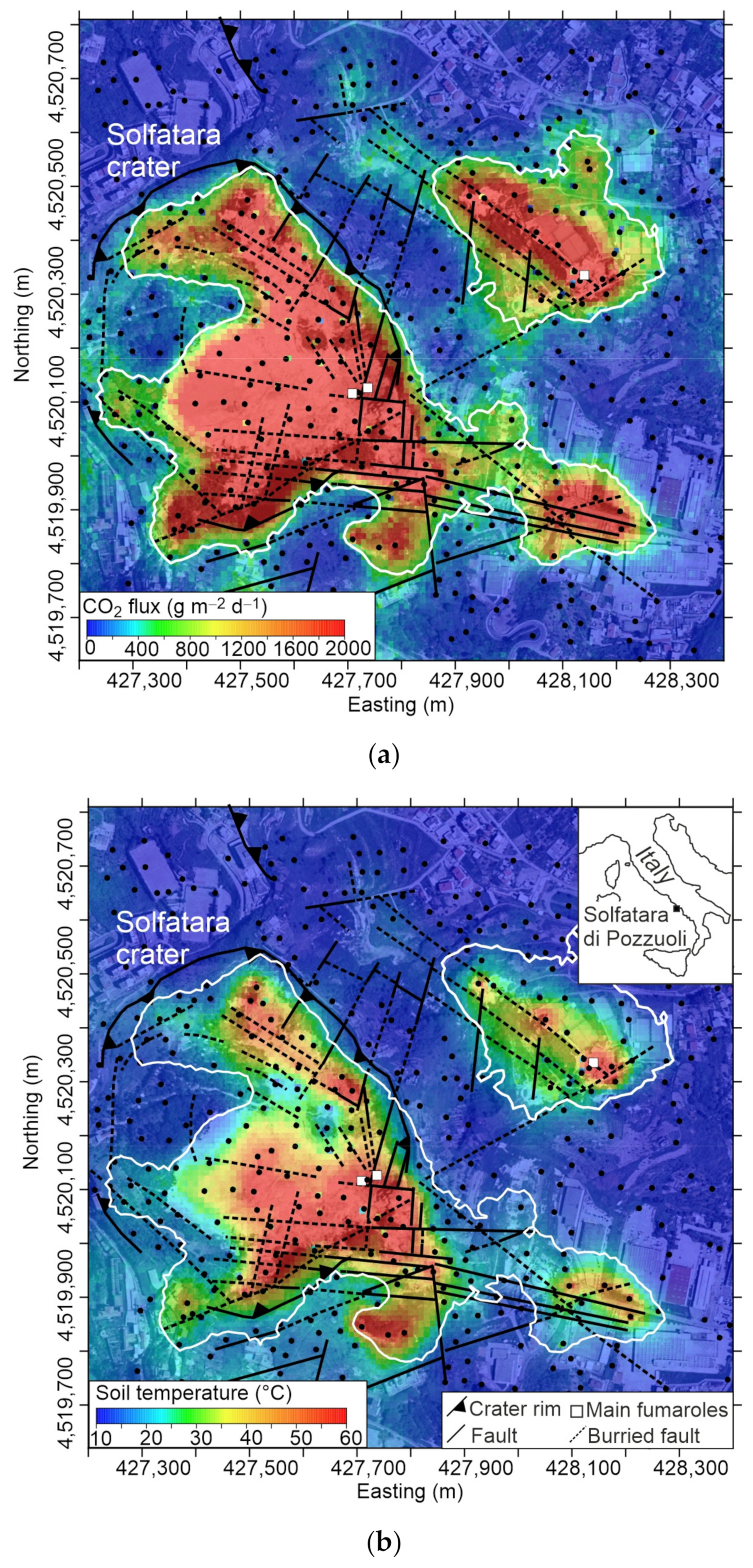
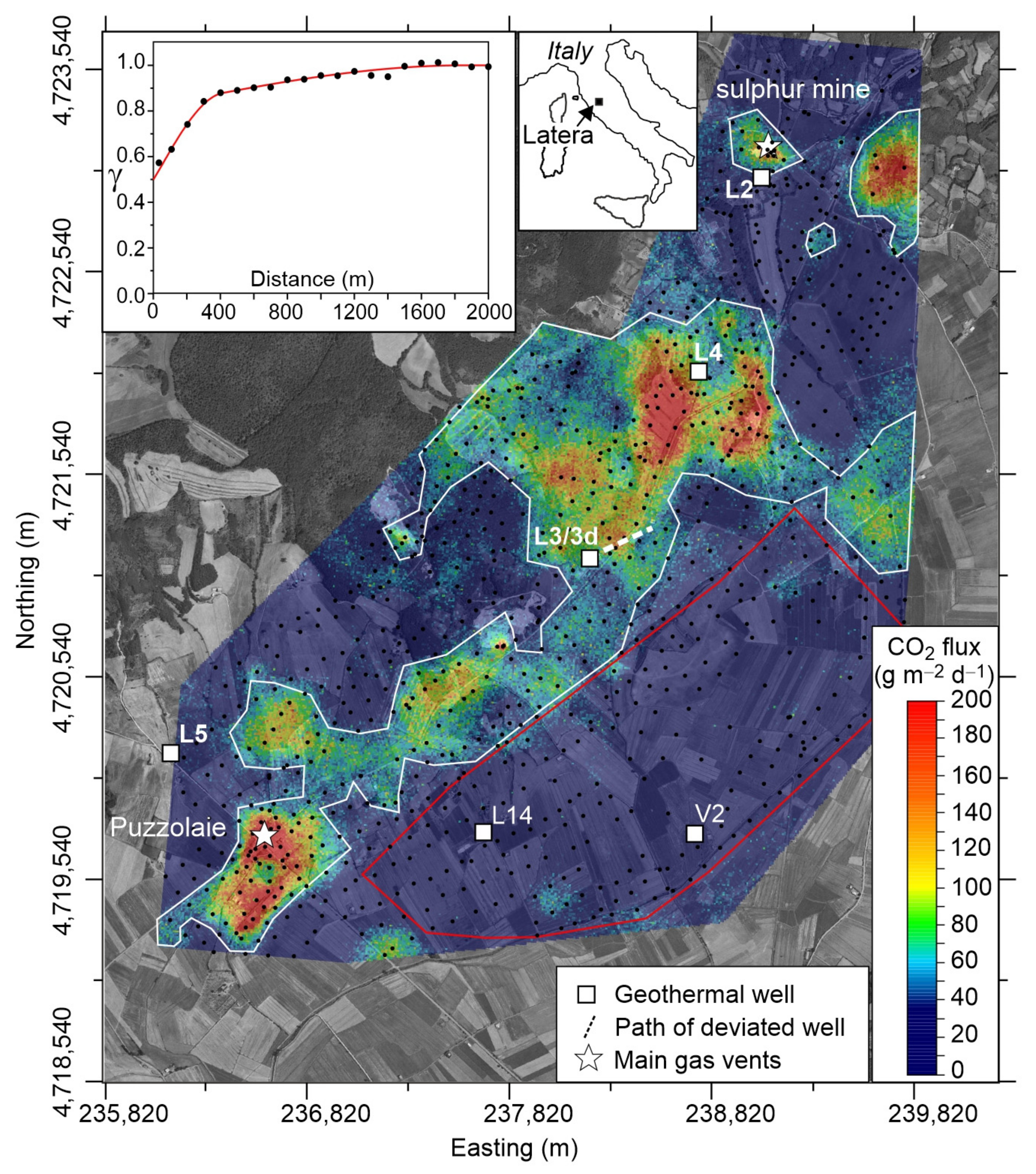
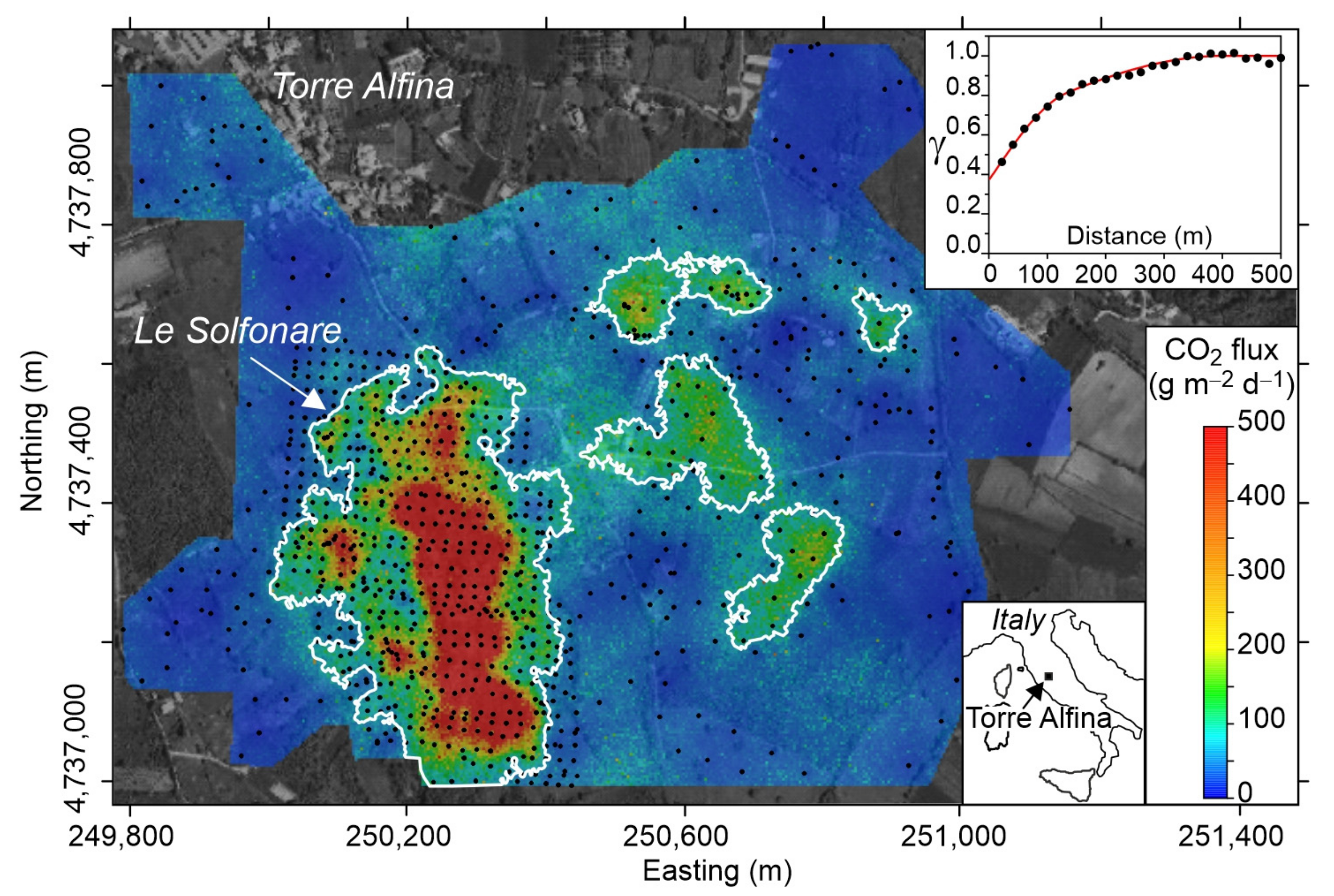

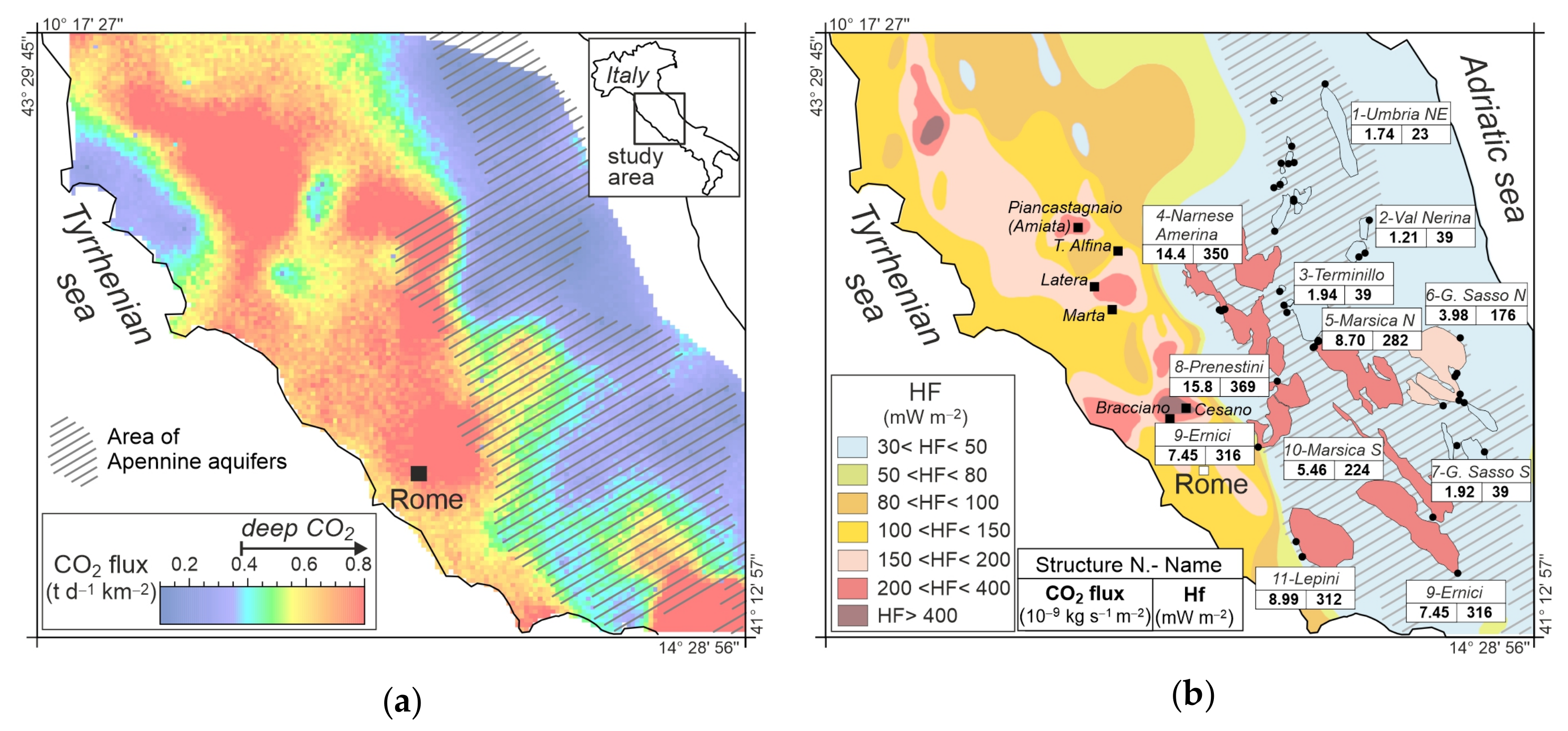
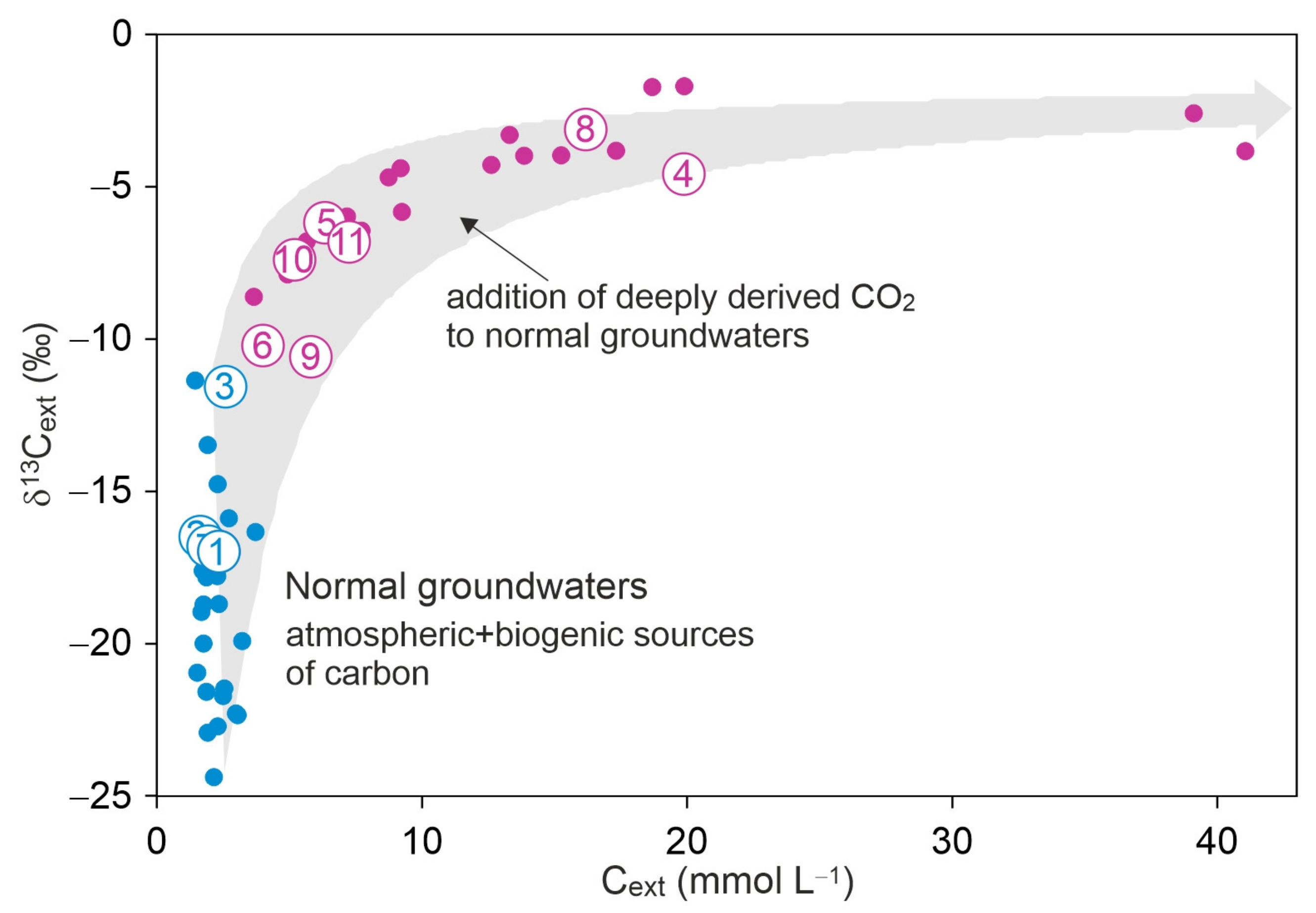
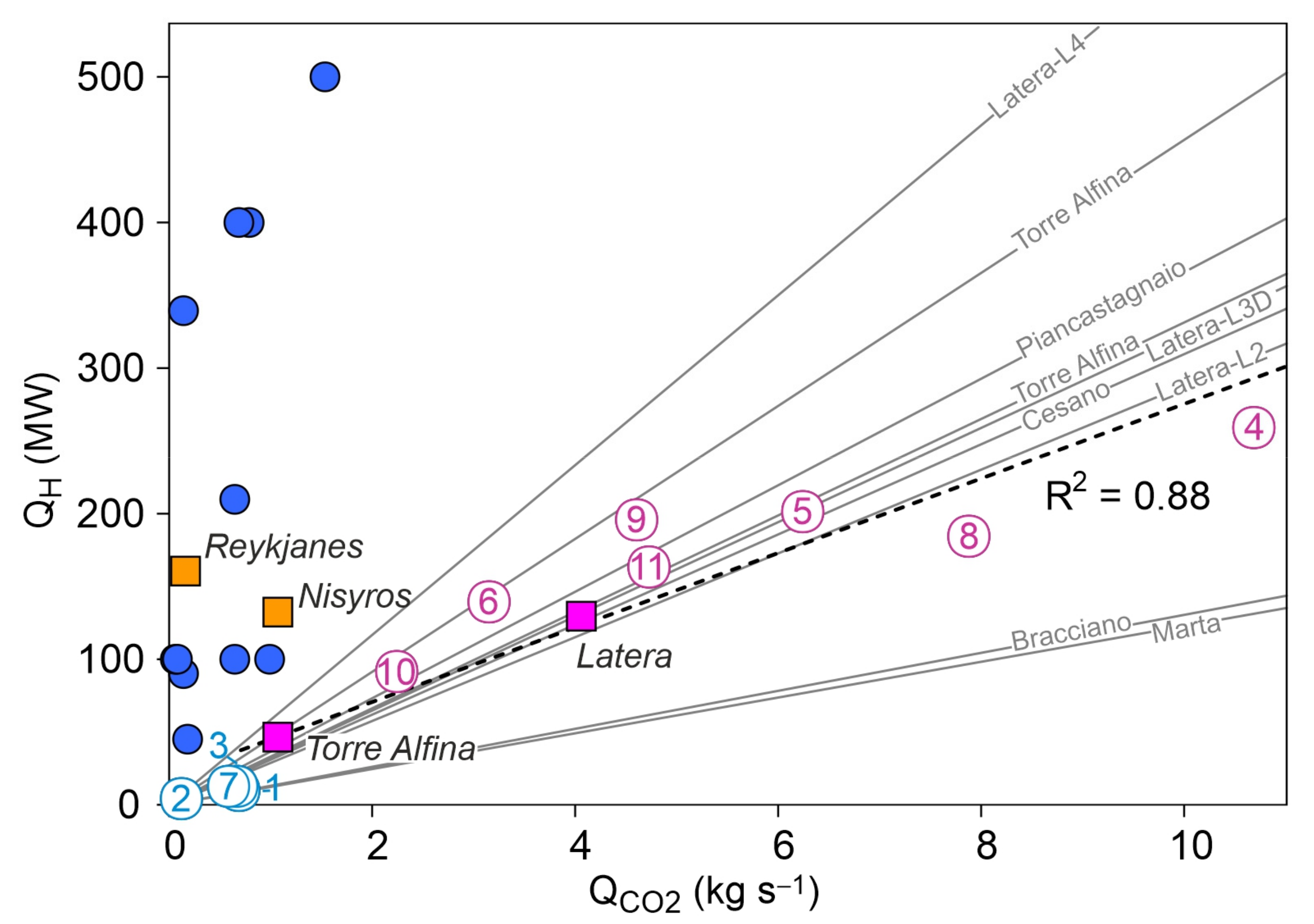
| Volcano (DDS) | Date | DDS Extent a km2 | RH2O/CO2 | QCO2 kg s−1 | Qcond kg s−1 | QH,cond MW | Reference |
|---|---|---|---|---|---|---|---|
| Campi Flegrei, Solfatara | 12/1998 | 0.454 b | 2.20 | 17.6 | 38.72 | 100.4 | [19] |
| Campi Flegrei, Solfatara | 07/2000 | 0.455 b | 2.27 | 17.13 | 38.88 | 100.8 | [6] |
| Ischia, Donna Rachele | 04/2001 | 0.058 | 147 | 0.11 | 15.48 | 40.1 | [6] |
| Vesuvio, cone | 04/2000 | 0.331 | 3.66 | 1.75 | 6.40 | 16.6 | [6] |
| Vulcano, crater | 07/1998 | 0.415 | 4.42 | 1.83 | 8.08 | 21.0 | [6] |
| Vulcano, PL Beach | 03/2002 | 0.018 | 5.24 | 0.22 | 1.15 | 3.0 | [6] |
| Pantelleria, Favara Grande | 07/2004 | 0.058 | 17.2 | 0.08 | 1.39 | 3.6 | [6] |
| Masaya, Comalito | 03/2003 | 0.010 | 1.60 | 0.22 | 0.35 | 0.9 | [6] |
| Yellowstone, Mud volcanoes | 08/2003 | 0.400 | 3.49 | 3.36 | 11.82 | 30.6 | [6] |
| Yellowstone (HSB) | - | 0.160 | 15.63 | 0.80 | 12.48 | 32.3 | [23] |
| Yellowstone (HLGB) | - | 0.040 | 250 | 0.02 | 5.79 | 15.0 | [23] |
| Yellowstone (CH) | 08/2014 | <0.035 c | 13.44 | 0.97 | 13.1 | 33.9 | [24] |
| Nisyros-Stefanos | 10/2018 | 0.086 | 36.0 | 0.19 | 7.00 | 18.1 | [25] |
| Nisyros-Kaminakia | 10/2018 | 0.164 | 6.90 | 0.16 | 1.08 | 2.8 | [25] |
| Nisyros-Polibote | 10/2018 | 0.031 | 26.0 | 0.07 | 1.68 | 4.4 | [25] |
| Nisyros-Phlegeton | 10/2018 | 0.053 | 21.2 | 0.04 | 0.85 | 2.2 | [25] |
| Nisyros Lofos | 10/2018 | 0.196 | 27.3 | 0.23 | 6.31 | 16.4 | [25] |
| Nisyros-Ramos | 10/2018 | 0.048 | 16.5 | 0.12 | 2.01 | 5.2 | [25] |
| Nisyros-NEfault | 10/2018 | 0.124 | 6.9 | 0.10 | 0.66 | 1.7 | [25] |
| Nisyros-SENWline | 10/2018 | 0.123 | 27.3 | 0.05 | 1.30 | 3.4 | [25] |
| Nisyros-NESWline | 10/2018 | 0.029 | 27.3 | 0.02 | 0.59 | 1.5 | [25] |
| Nisyros, all DDSs | 10/2018 | 0.825 | 6.9–36 | 1.06 | 23.40 | 60.7 | [25] |
| Nisyros, all DDSs | 02/2000 | 0.690 | 6.1–36 | 0.79 | 16.44 | 42.6 | [26] |
| Copahue-Las Máquinas | 03/2014 | <0.321 c | 15.8 | 0.43 | 6.73 | 14.9 | [27] |
| Copahue-Las Maquinitas I+II | 03/2014 | <0.079 c | 17.3 | 0.19 | 3.30 | 7.3 | [27] |
| Termas Copahue | 03/2014 | <0.576 c | 16.6 | 1.05 | 17.45 | 38.7 | [27] |
| Terceira-Furnas do Enxofre | 08/2014 | <0.024 c | 14.9 | 0.03 | 0.44 | 1.1 | [28] |
| Teide | 07/2016 | <0.560 c | 2.24 | 2.44 | 5.47 | 14.2 | [29] |
| Peteroa | 01/2020 | <0.08 c | 12.9 | 0.08 | 0.77 | 2.6 | [30] |
| Name | QCO2 kg s−1 | mCO2 mol kg−1 | TL °C | HL kJ kg−1 | QL kg s−1 | QH MW |
|---|---|---|---|---|---|---|
| Reykjanes 1 | 0.156 | 0.0284 | 290 | 1289 | 125 | 161 |
| Nisyros 2 | 1.060 | 0.29 | 340 | 1594 | 83.9 | 134 |
| Torre Alfina | 1.064 | 0.33 | 150 | 632.2 | 73.3 | 46 |
| Latera | 4.050 | 0.73 | 238 | 1028 | 126.1 | 130 |
| Population | Mean Log CO2 Flux | σ | % | Mean CO2 Flux * g m−2 d−1 |
|---|---|---|---|---|
| 1 | 1.05 | 0.30 | 33 | 14.2 (13.3–15.2) |
| 2 | 1.62 | 0.29 | 46 | 52.1(49.4–54.8) |
| 3 | 2.15 | 0.75 | 21 | 626 (441–905) |
| N. | Name | Q m3 s−1 | A km2 | Hf mW m−2 | QH MW | CO2 Flux kg s−1 m−2 | QCO2 kg s−1 |
|---|---|---|---|---|---|---|---|
| 1 | Umbria NE | 6.73 | 399 | 23 | 9.3 | 1.74 × 109 | 0.69 |
| 2 | Val Nerina | 1.78 | 105 | 39 | 4.1 | 1.21 × 109 | 0.13 |
| 3 | Terminillo | 5.79 | 340 | 39 | 13.2 | 1.94 × 109 | 0.66 |
| 4 | Narnese-Amerina | 15.00 | 740 | 350 | 259.4 | 1.44 × 108 | 10.67 |
| 5 | Marsica N | 22.35 | 716 | 282 | 202.2 | 8.70 × 109 | 6.23 |
| 6 | G Sasso N | 17.95 | 793 | 176 | 139.9 | 3.98 × 109 | 3.16 |
| 7 | G Sasso S | 7.00 | 309 | 39 | 12.2 | 1.92 × 109 | 0.59 |
| 8 | Prenestini | 9.00 | 499 | 369 | 184.3 | 1.58 × 108 | 7.87 |
| 9 | Ernici | 18.00 | 618 | 316 | 195.5 | 7.45 × 109 | 4.60 |
| 10 | Marsica S | 9.80 | 411 | 224 | 91.9 | 5.46 × 109 | 2.24 |
| 11 | Lepini | 14.80 | 525 | 312 | 163.7 | 8.99 × 109 | 4.72 |
Publisher’s Note: MDPI stays neutral with regard to jurisdictional claims in published maps and institutional affiliations. |
© 2021 by the authors. Licensee MDPI, Basel, Switzerland. This article is an open access article distributed under the terms and conditions of the Creative Commons Attribution (CC BY) license (https://creativecommons.org/licenses/by/4.0/).
Share and Cite
Chiodini, G.; Cardellini, C.; Bini, G.; Frondini, F.; Caliro, S.; Ricci, L.; Lucidi, B. The Carbon Dioxide Emission as Indicator of the Geothermal Heat Flow: Review of Local and Regional Applications with a Special Focus on Italy. Energies 2021, 14, 6590. https://doi.org/10.3390/en14206590
Chiodini G, Cardellini C, Bini G, Frondini F, Caliro S, Ricci L, Lucidi B. The Carbon Dioxide Emission as Indicator of the Geothermal Heat Flow: Review of Local and Regional Applications with a Special Focus on Italy. Energies. 2021; 14(20):6590. https://doi.org/10.3390/en14206590
Chicago/Turabian StyleChiodini, Giovanni, Carlo Cardellini, Giulio Bini, Francesco Frondini, Stefano Caliro, Lisa Ricci, and Barbara Lucidi. 2021. "The Carbon Dioxide Emission as Indicator of the Geothermal Heat Flow: Review of Local and Regional Applications with a Special Focus on Italy" Energies 14, no. 20: 6590. https://doi.org/10.3390/en14206590
APA StyleChiodini, G., Cardellini, C., Bini, G., Frondini, F., Caliro, S., Ricci, L., & Lucidi, B. (2021). The Carbon Dioxide Emission as Indicator of the Geothermal Heat Flow: Review of Local and Regional Applications with a Special Focus on Italy. Energies, 14(20), 6590. https://doi.org/10.3390/en14206590






